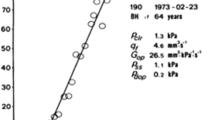Abstract
Outflow conductance (C out) is important for predicting shunt responsiveness in patients with suspected idiopathic adult hydrocephalus syndrome (IAHS). C out is determined by performing an infusion test into the cerebrospinal fluid system, and the reliability of the test is dependent on the measurement time. The objective of this study was to develop an adaptive signal analysis method to reduce the investigation time, by taking the individual intracranial pressure variations of the patient into consideration. The method was evaluated on 28 patients with suspected IAHS. The results from full time investigations (60 min) were compared to the results of the new algorithm. Applying the new adaptive method resulted in a reduction of mean investigation time by 14.3 ± 5.9 min (mean ± SD), p < 0.01. The reduction of reliability in the C out estimation was found clinically negligible. We thus recommend this adaptive method to be used when performing constant pressure infusion tests.






Similar content being viewed by others
References
Andersson N, Malm J, Bäcklund T, Eklund A (2005) Assessment of cerebrospinal fluid outflow conductance using constant-pressure infusion—a method with real time estimation of reliability. Physiol Meas 26:1137–1148
Boon AJ, Tans JT, Delwel EJ, Egeler_Peerdeman SM, Hanlo PW, Wurzer HA, Avezaat CJ, De Jong DA, Gooskens RH, Hermans J (1997) Dutch normal-pressure hydrocephalus study: prediction of outcome after shunting by resistance to outflow of cerebrospinal fluid. J Neurosurg 87:687–693
Borgesen SE, Albeck MJ, Gjerris F, Czosnyka M, Laniewski P (1992) Computerized infusion test compared to steady pressure constant infusion test in measurement of resistance to CSF outflow. Acta Neurochir (Wien) 119:12–16
Borgesen SE, Gjerris F (1982) The predictive value of conductance to outflow of CSF in normal pressure hydrocephalus. Brain 105:65–86
Brockwell PJ, Davis RA (2002) Introduction to time series and forecasting, 2nd edn. Springer, New York
Czosnyka M, Batorski L, Laniewski P, Maksymowicz W, Koszewski W, Zaworski W (1990) A computer system for the identification of the cerebrospinal compensatory model. Acta Neurochir (Wein) 105:112–116
Czosnyka M, Whitehouse H, Smielewski P, Simac S, Pickard JD (1996) Testing of cerebrospinal compensatory reserve in shunted and non-shunted patients: a guide to interpretation based on an observational study. J Neurol Neurosurg Psychiatr 60:549–558
Ekstedt J (1977) CSF hydrodynamic studies in man. 1. Method of constant pressure CSF infusion. J Neurol Neurosurg Psychiatr 40:105–119
Ekstedt J (1978) CSF hydrodynamic studies in man. 2. Normal hydrodynamic variables related to CSF pressure and flow. J Neurol Neurosurg Psychiatr 41:345–353
Kay S, Marple S (1981) Spectrum analysis—a modern perspective. Proc IEEE 69:1380–1417
Kosteljanetz M (1985) Resistance to outflow of cerebrospinal fluid determined by bolus injection technique and constant rate steady state infusion in humans. Neurosurgery 16:336–340
Lundberg N (1960) Continuous recording and control of ventricular fluid pressure in neurosurgical practice. Acta Psychiatr Scand 36(Suppl 149):1–193
Lundkvist B, Eklund A, Kristensen B, Fagerlund M, Koskinen LO, Malm J (2001) Cerebrospinal fluid hydrodynamics after placement of a shunt with an antisiphon device: a long-term study. J Neurosurg 94:750–756
Malm J, Eklund A (2006) Idiopathic normal pressure hydrocephalus. Pract Neurol 6:14–27
Malm J, Kristensen B, Karlsson T, Fagerlund M, Elfverson J, Ekstedt J (1995) The predictive value of cerebrospinal fluid dynamic tests in patients with the idiopathic adult hydrocephalus syndrome. Arch Neurol 52:783–789
Marmarou A, Bergsneider M, Klinge P, Relkin N, Black P (2005) The value of supplemental Prognostic tests for the preoperative assessment of idiopathic normal-pressure hydrocephalus. Neurosurgery 57:17–28
Marmarou A, Young HF, Aygok GA, Sawauchi S, Tsuji O, Yamamoto T, Dunbar J (2005) Diagnosis and management of idiopathic normal-pressure hydrocephalus: a prospective study in 151 patients. Neurosurgery 102:987–997
Marmarou A, Shulman K, Rosende RM (1978) A nonlinear analysis of the cerebrospinal fluid system and intracranial pressure dynamics. J Neurosurg 48:332–344
Meier U, Zeilinger FS, Kintzel D (1999) Diagnostic in normal pressure hydrocephalus: a mathematical model for determination of the ICP-dependent resistance and compliance. Acta Neurochir (Wien) 141:941–947; discussion 947–948
Rosner B (2000) Fundamentals of biostatistics, 5th edn. Duxbury, Pacific Grove
Stephensen H, Andersson N, Eklund A, Malm J, Tisell M, Wikkelsö C (2005) Objective B wave analysis in 55 patients with non-communicating and communicating hydrocephalus. J Neurol Neurosurg Psychiatr 76:965–970
Tans JT, Poortvliet DC (1985) CSF outflow resistance and pressure-volume index determined by steady-state and bolus infusions. Clin Neurol Neurosurg 87:159–165
Van Der Leeuw J (1994) The covariance matrix of ARMA errors in closed form. J Econom 63:397–405
Author information
Authors and Affiliations
Corresponding author
Rights and permissions
About this article
Cite this article
Andersson, N., Malm, J., Wiklund, U. et al. Adaptive method for assessment of cerebrospinal fluid outflow conductance. Med Bio Eng Comput 45, 337–343 (2007). https://doi.org/10.1007/s11517-006-0157-7
Received:
Accepted:
Published:
Issue Date:
DOI: https://doi.org/10.1007/s11517-006-0157-7




